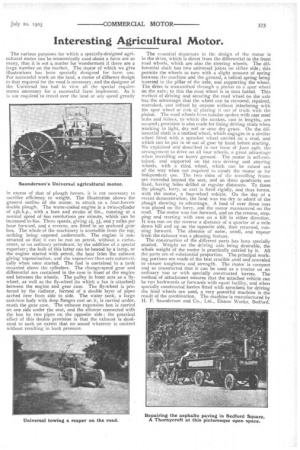Interesting Agricultural Motor.
Page 13

If you've noticed an error in this article please click here to report it so we can fix it.
The various purposes for which a specially-designed agricultural motor can be economically used about a farm are so many, that it is not a matter for wonderment if there are a large number on the market. The motor of which we give illustrations has been specially designed for farm use. For successful work on the land, a motor of different design to that required for the raid is necessary, and the designer of the Universal has had in view all the special requirements necessary for a successful farm implement. As it is not required to travel over the land at any speed greatly in excess of that of plough horses, it is not necessary to sacrifice efficiency to weight. The illustration shows the general outline of the motor, to attach to a four-furrow double plough. The water-cooled engine is a twin-cylinder of 25b.h.p., with a bore and stroke of 6in., running at a normal speed of 600 revolutions per minute, which can be increased to 800. Three speeds, giving 2/, 3/, and 7 miles per hour forward, and a reverse, are fitted in an enclosecl gede box. The whole of the machinery is accessible from the top, nothing being exposed underneath. The engine is constructed so that it can be run on petrol, without a carburetter, or on ordinary petroleum, by the addition of a special vaporiser ; the bulb of this latter can be heated by a lamp, or the engine started with petrol, the heat frdm the exhaust giving vapourisation, and the vapouriser then acts automatically when once started. The fuel is contained in a tank mounted above the cylinders. The change-speed gear and differential are contained in the case in front of the engine and between the wheels. The pulley in front acts as a flywheel, as well as the fly-wheel (to which a fan is attached) between the engine and gear case. The fly-wheel is protected by the radiator, formed of a double layer of pipes arched over from side to side. The water tank, a large cast-iron body with deep flanges cast on it, is carried underneath the gear case. The exhaust expansion box is carried on one side under the seat, and the silencer connected with the box by two pipes on the opposite side : the practical effect of this double provision is that the exhaust is deadened to such an extent that no sound whatever is emitted without resulting in back pressure. The essential departure in the design of the motor is in the drive, which is direct from the differential to the front road wheels, which are also the steering wheels. The differential shaft has two universal joints on either side; this permits the wheels to turn with a slight amount of spring between the machine and the ground, a helical spring being inserted in the pillar of the axle, and supporting the wheel. The drive is transmitted through a pinion to a spur wheel on the axle; to this the road wheel is in turn bolted. This method of driving and securing the road wheel on the axle has the advantage that the wheel can be removed, repaired, restraked, and refixed by anyone without interfering with the spur wheel or risk of placing it out of truth with the pinion. The road wheels have tubular spokes with cast steel hubs and felloes, to which the strakes, cast in lengths, are secured; provision is also wade for fixing driving studs when working in light, dry soil or over dry grass. On the differential shaft is a toothed wheel, which engages in a similar wheel fitted with a sprocket wheel carried on a stud, and which can be put in or out of gear by hand before starting. We explained and described in our issue of June 29th, the arrangement to drive on all four wheels, a great advantage when travelling on heavy ground. The motor is self-contained, and supported on the two driving and steering wheels, with a third wheel, which can be raised out of the way when not required to steady the motor or for independent use. The two sides of the travelling frame are extended beyond the seat, and on them quadrants are fixed, having holes drilled at regular distances. To these the plough, lorry, or cart is fixed rigidly, and thus forms, with the motor, a four-wheel vehicle. On the day of a recent demonstration, the land was too dry to admit of the plough showing to advantage. A load of over three tons was placed on the lorry, and the motor manceuvred on the road. The motor was run forward, and on the reverse, stopping and starting with ease on a hill in either direction. It was run on the reverse a distance of a quarter of a mile down hill and up on the opposite side, then returned, running forward. The absence of noise, smell, and vapour from the exhaust was a pleasing feature. The construction of the different parts has been specially studied. Weight on the driving axle being desirable, the whole weight of the motor is practically carried by it. All the parts are of substantial proportion. The principal working portions are made of the best crucible steel and annealed to ensure toughness and strength. The motor is compact and so constructed that it can be used as a tractor on an ordinary van or with specially constructed lorries. The method of attachment ensures that the attached vehicle can be run backwards or forwards with equal facility, and when specially constructed lorries fitted with sprockets for driving the hind wheels are used, a very powerful machine is the result of the combination. The machine is manufactured by H. P. Saunderson and Co., Ltd., Elstow Works, Bedford.


















